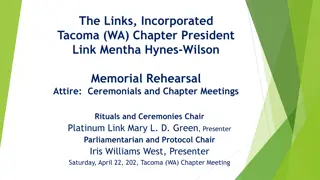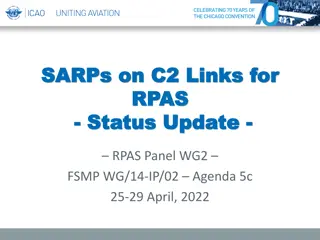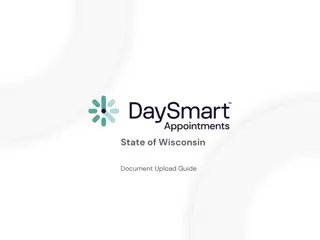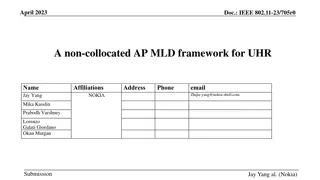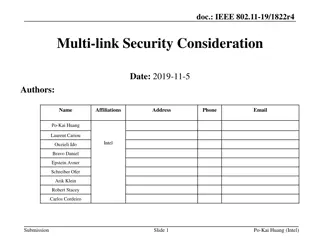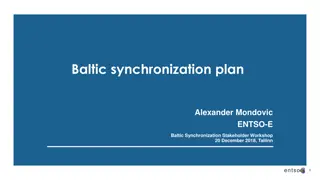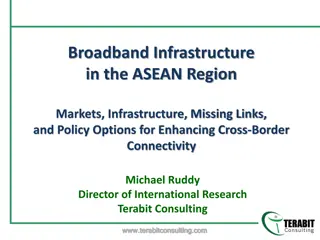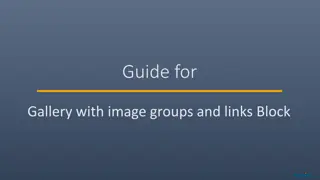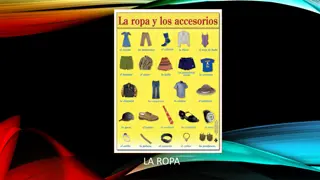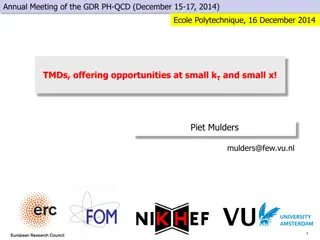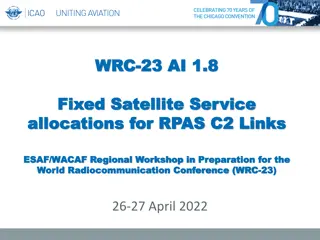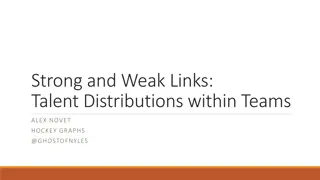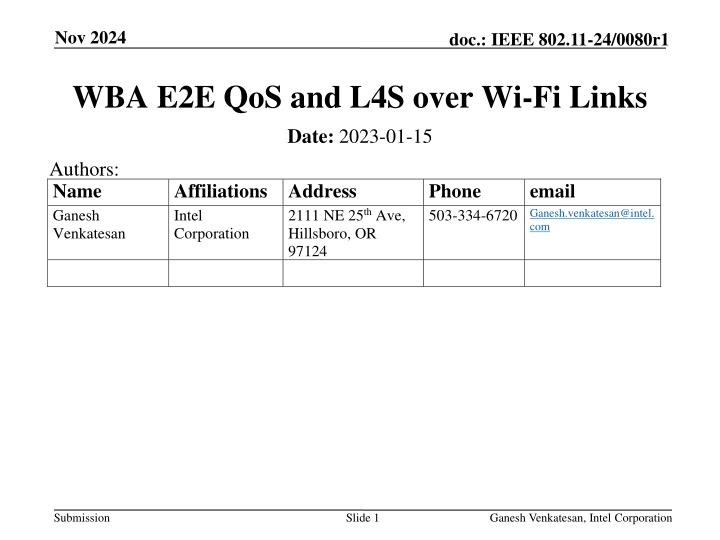
Enhancing Wi-Fi Performance with L4S Technology
Explore the impact of L4S technology on Wi-Fi performance, focusing on latency-sensitive applications and throughput demands. Gain insights on tradeoffs for better latency and how L4S enables high-rate data transmission while maintaining latency performance.
Download Presentation

Please find below an Image/Link to download the presentation.
The content on the website is provided AS IS for your information and personal use only. It may not be sold, licensed, or shared on other websites without obtaining consent from the author. If you encounter any issues during the download, it is possible that the publisher has removed the file from their server.
You are allowed to download the files provided on this website for personal or commercial use, subject to the condition that they are used lawfully. All files are the property of their respective owners.
The content on the website is provided AS IS for your information and personal use only. It may not be sold, licensed, or shared on other websites without obtaining consent from the author.
E N D
Presentation Transcript
Nov 2024 doc.: IEEE 802.11-24/0080r1 WBA E2E QoS and L4S over Wi-Fi Links Date: 2023-01-15 Authors: Name Ganesh Venkatesan Affiliations Address Intel Corporation Phone 503-334-6720 Ganesh.venkatesan@intel. com email 2111 NE 25th Ave, Hillsboro, OR 97124 Submission Slide 1 Ganesh Venkatesan, Intel Corporation
Nov 2024 doc.: IEEE 802.11-24/0080r1 Abstract Document 23/1206 was presented in the July 23 Plenary where we described the WBA E2E QoS project Phase-1. We also mentioned a Phase-2 of the project where E2E QoS (optimizing QoS end-to-end over links that are not exclusively IEEE802.11 links). Document 23/2118 was discussed in the Nov 23 Plenary the discussion led to (a) interest in performance improvement for latency sensitive traffic when L4S is enabled over the 802.11 link, and (b) a look at IEEE802.1Q-2022 Clause 30, 31, 32 and 33 in the context of IEEE802.11 MAC/PHY The mechanisms defined in IEEE802.1Q-2022 target networks with low bandwidth-delay product (5 Mbits or less), specifically Data Center Ethernet. These mechanisms, however, can co-exist and work with higher layer congestion management protocols like L4S. This submission covers the following: What gain does L4S over Wi-Fi providefor Latency-sensitive traffic? At what cost? Can Quantized Congestion Notification (.1Q-2020 Cl. 30.2) be used in managed Wi-Fi deployments to achieve bounded latency? Submission Slide 2 Ganesh Venkatesan, Intel Corporation
Jan 2024 doc.: IEEE 802.11-24/0080r1 L4S Performance in a proof-of-concept implementation Focus is on downlink performance The medium access used in the setup is EDCA (.11ac and below; no triggered access Goal was to demonstrate bounded latency for latency-sensitive and throughput-demanding flows in the presence of network load Setup The AP has a dual queue coupled AQM (RFC 9332) implementation (an L4S queue and a non-L4S queue) 20MHz channel in an open office environment (the channel was in use by other BSSs). Five bi-directional 25 Mbps traffic in 5 AP-STA pairs. Single AP-STA pair under test 5 TCP downstream flows to the STA either TCP-Cubic (non-L4S) and TCP-Prague (L4S) Submission Slide 3 Ganesh Venkatesan, Intel Corporation
Jan 2024 doc.: IEEE 802.11-24/0080r1 Nokia Beacon 6 Wi-Fi AP 2 separate experiments downstream measured: Orange = 5 TCP-Cubic flows on Beacon6 without DualPI2 Blue = 5 TCP-Prague flows on Beacon6 with DualPI2 enabled Classic Latency L4S Latency Classic Thruput L4S Thruput P99 Latency L4S: 13 ms Classic: 274 ms Submission Slide 4 Ganesh Venkatesan, Intel Corporation
Jan 2024 doc.: IEEE 802.11-24/0080r1 L4S: Tradeoff Through for better latency As can be seen from the Data Rate Time Series plot, L4S gains latency performance by trading off throughput With classic behavior (without L4S), Wi-Fi link would be unusable for interactive latency-sensitive applications. L4S enables latency-sensitive apps to maintain latency performance while sending at high rate. Submission Slide 5 Ganesh Venkatesan, Intel Corporation
Jan 2024 doc.: IEEE 802.11-24/0080r1 Detect and Notify Congestion Tx buffer is getting filled such that the transmission of the one or more of the frames in the queue will exceed the latency deadline for the frame(s) With IEEE802.11 this depends on the channel conditions, mechanism used to access the channel (EDCA versus Triggered Access) L4S operation: In heterogeneous IP networks, L4S provides end-to-end [Transport Layer] Congestion Notification The 802.11 MAC has the best knowledge of the channel conditions and can set the ECN bits in the IP header (to congestion experienced), Propagates to the Listener which causes a higher layer ECN message to be sent to the Talker IEEE802.1Q QCN operation: defined for data-center networks (BDP < 50mbits), can initiate the CP Algorithm as defined in Cl. 30.2.1 of IEEE802.1Q-2022 Causes an L2 Congestion Notification Message (CNM) to be sent from the Congestion Point directly to the Talker Submission Slide 6 Ganesh Venkatesan, Intel Corporation
Nov 2024 doc.: IEEE 802.11-24/0080r1 General Approach to mitigating latency issues At each node in the path between the Talker and the Listener, keep buffering small enough to meet latency requirements Proactively signal congestion conditions and Leverage drop-eligibility, if available L4S: Provide feedback to the Talker to throttle down transmission (TCP Prague) requires only support at the Talker, Listener and weak links E.g., adapt to congestion conditions by reducing requirements (drop to a lower video resolution, more aggressive compression, etc.) Needs further study: IEEE802.1Q-2022 Congestion Detection/Notification, Congestion Isolation (IEEE802.1Qcz-2023) when Bandwidth Delay Product meets .1Q design constraints Requires support in all the nodes end to end May fit only constrained deployments (managed networks, factory automation, etc) Some implementation-specific strategies Distinct queues for latency-bound and non-latency-bound traffic (DSCP-agnostic) Submission Slide 7 Ganesh Venkatesan, Intel Corporation
Nov 2024 doc.: IEEE 802.11-24/0080r1 Next Steps Support for ECN IP Headers, LLDP TLV (Access Points) Support for Network Congestion Notification above the IP layer (e.g., RTP over UDP or TCP headers) Define primitives for exchange of information from the IEEE802.11 MAC to higher layers Over-the-air signaling indicating support for L4S Explore IEEE802.1Q-2022 QCN for managed Wi-Fi deployments (factory automation) Explore if the benefits of L4S and IEEE802.1Q-2022 QCN are additive Submission Slide 8 Ganesh Venkatesan, Intel Corporation
Nov 2024 doc.: IEEE 802.11-24/0080r1 References https://mentor.ieee.org/802.11/dcn/23/11-23-2065-00-0wng- l4s-and-implications-for-wi-fi.pptx Greg White (CableLabs) L4S Architecture: https://datatracker.ietf.org/doc/rfc9330/ Discussion on considerations prior to deploying L4S over Wi-Fi: domos.no/blog/an-introduction-to-l4s Quantized Congestion Notification: https://www.ietf.org/proceedings/87/slides/slides-87-iccrg- 9.pdf IEEE802.1Q-2022: https://standards.ieee.org/ieee/802.1Q/10323/ Submission Slide 9 Ganesh Venkatesan, Intel Corporation
Nov 2024 doc.: IEEE 802.11-24/0080r1 Backup Submission Slide 10 Ganesh Venkatesan, Intel Corporation
Jan 2024 doc.: IEEE 802.11-24/0080r1 TCP Evolution Reference: Document 11-23/2065r0 (Greg White, CableLabs) TCP Reno (1986): Uses a linear function to increase window size; low BDP conditions; Packet loss indicates congestion TCP CUBIC (2008): most deployed flavor; uses a cubic function to increase window size, large BDP conditions; packet loss indicates congestion TCP Prague: Explicit Congestion Notification [transport layer] messages indicates congestion (no packet loss); early and frequent signaling of congestion prior to any packet loss. Submission Slide 11 Ganesh Venkatesan, Intel Corporation
Nov 2023 doc.: IEEE 802.11-23/2065r0 Fairness to Classic traffic: DualPI2 (RFC9332) How does it work Network node Interactive applications set L4S ECT1 in IP header and use L4S CC & >1ms ECN Classifier Congestion Control Overrules scheduling Prague qL pL L4S CE marker ect(1), ce ? 2 ? 90% WRR Classic ? 1 ? 10% ect(0), non-ect Drop Reno/Cubic qC Download applications set non-ECT and use Classic CCs 2p Every 15ms PI2 p pC Slide 12 Submission 12 Greg White et al, CableLabs
Jan 2024 doc.: IEEE 802.11-24/0080r1 Discussion Tx Queueing strategies Single MAC layer Queue Dual MAC layer Queues (one for L4S and one for non-L4S) PoC implementation Network layer congestion management is orchestrated by L4S and is media agnostic MAC layer congestion management as defined in IEEE802.1Q Cl. 30-33 30.2 CP Algorithm and RP Algorithm need to be revisited for IEEE802.11 media Enabled only when Bandwidth Delay Product is less than 50 mbits Can this augment congestion management protocol and provide additional benefit? Submission Slide 13 Ganesh Venkatesan, Intel Corporation
Nov 2024 doc.: IEEE 802.11-24/0080r1 End-to-End QoS Enablement in Wired/Wireless (IEEE802.11) deployments Leveraging .1Qcz mechanisms (IEEE802.1Qcz-2023 Cl. 49) and IEEE802.1Q-2022 Clause 30 (Principles of Congestion Notification) Low Latency Low Loss Scalable Throughput (L4S) a fast and explicit feedback loop from the network node managing the queue latency to the end systems and applications Submission Slide 14 Ganesh Venkatesan, Intel Corporation





